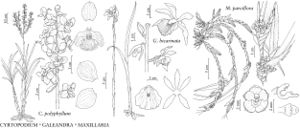Sisyrinchium septentrionale
Bull. Torrey Bot. Club 26: 452. 1899.
Herbs, perennial, cespitose, green to pale olive when dry, to 4.3 dm, not glaucous; rhizomes scarcely discernable. Stems simple, 0.8–2 mm wide, glabrous, margins usually entire to denticulate apically, similar in color and texture to stem body. Leaf-blades glabrous, bases not persistent in fibrous tufts. Inflorescences borne singly; spathes usually green, glabrous, keels entire to slightly denticulate; outer 20–63 mm, 17–42 mm longer than inner, tapering evenly towards apex, basally connate 1.5–2.5 mm; inner with keel evenly curved, hyaline margins 0.1–0.3 mm wide, apex acute to acuminate, ending 0.4–2.3 mm proximal to green apex. Flowers: tepals pale blue to light bluish violet, rarely white, bases yellow; outer 8–9.1 mm, apex usually rounded, aristate; filaments connate ± entirely, stipitate-glandular basally; ovary similar in color to foliage. Capsules beige to light-brown, ± globose, 3–5 mm; pedicel spreading to erect. Seeds globose to obconic, lacking obvious depression, 0.5–1.2 mm, rugulose. 2n = 32.
Phenology: Flowering early–mid summer.
Habitat: Mesic to dry meadows, stream banks, often in gravelly soil
Elevation: 500–1600 m
Distribution

Alta., B.C., N.W.T., Sask., Wash.
Discussion
Sisyrinchium septentrionale is widespread but apparently not common in western Canada. In central Canada it intergrades with S. mucronatum, to which it appears closely related (see discussion, p. 367). It is confused also with S. montanum but can be distinguished by its very slender, very long outer spathe and nongibbous inner spathe. Fresh material will show lighter blue flowers and outer tepals with rounded apices.
Selected References
None.
